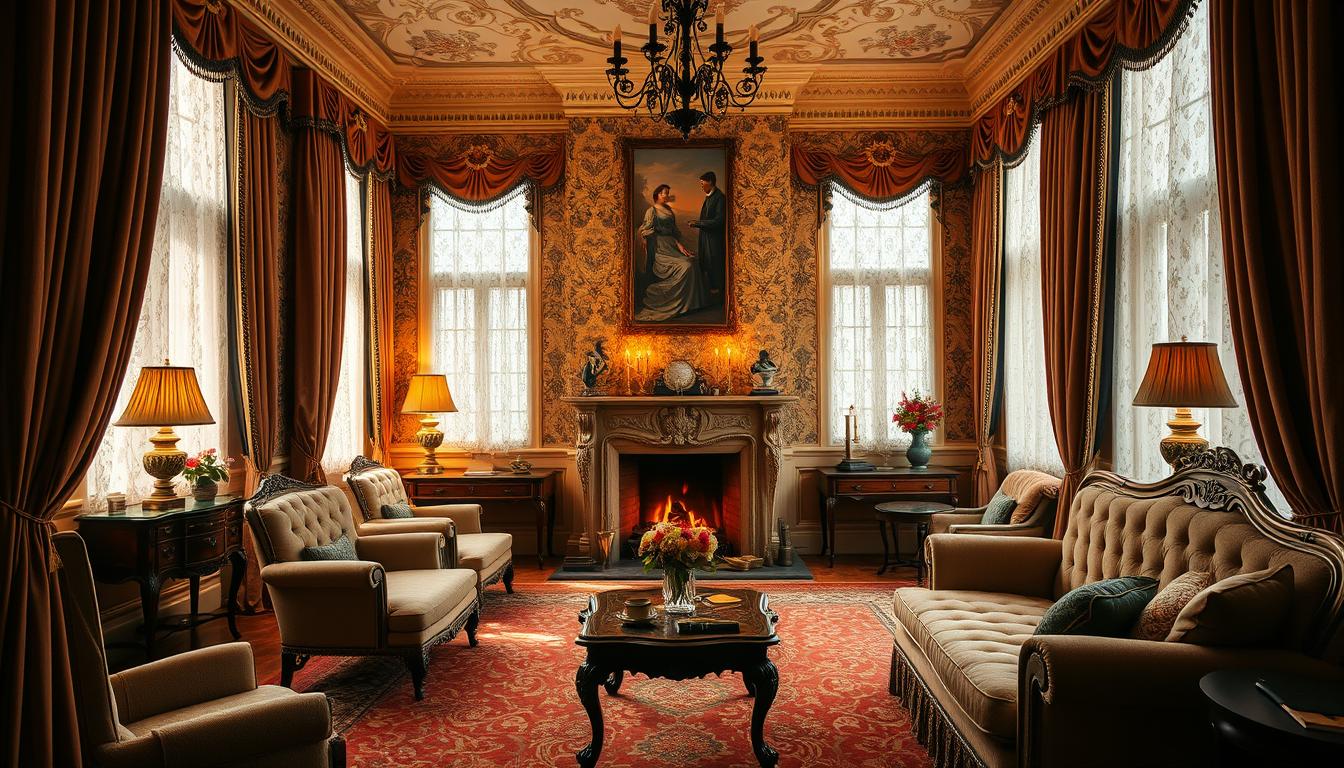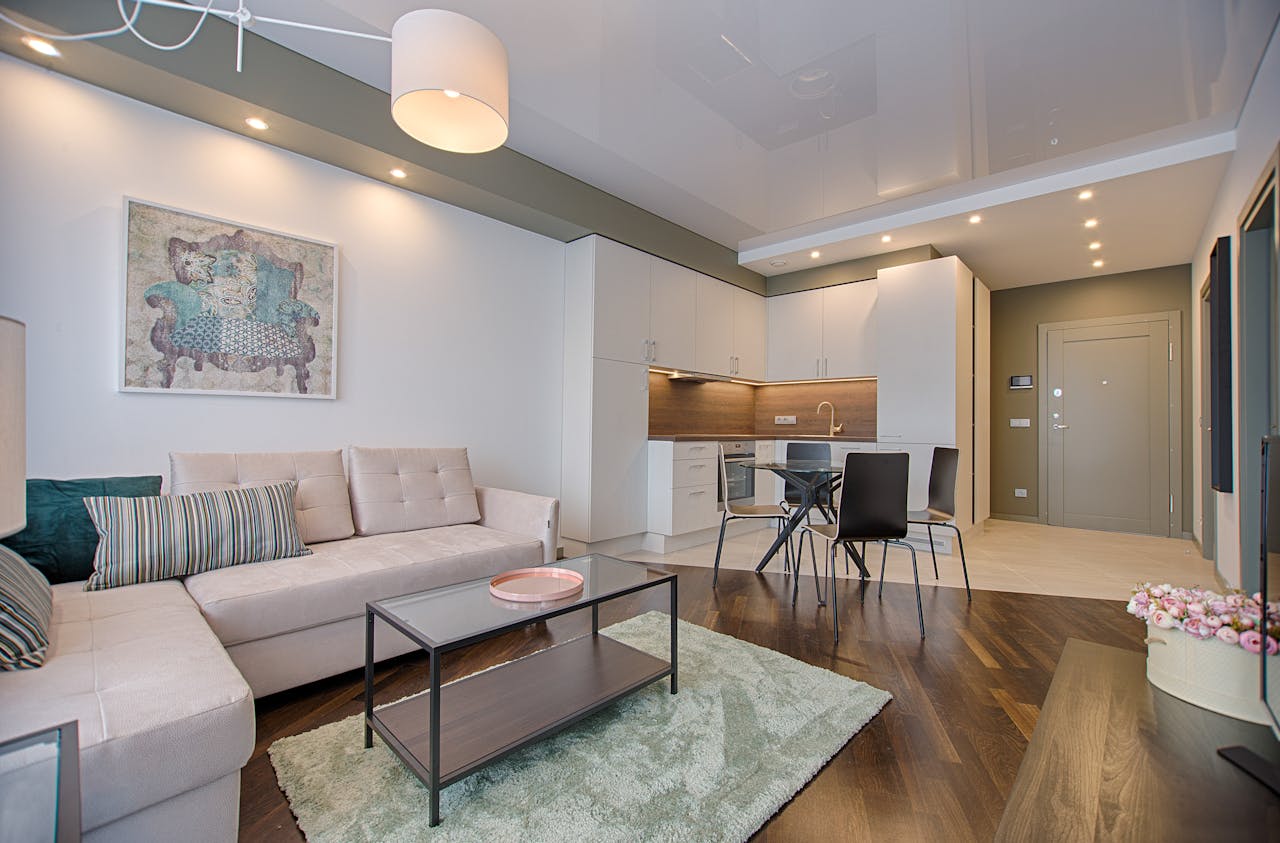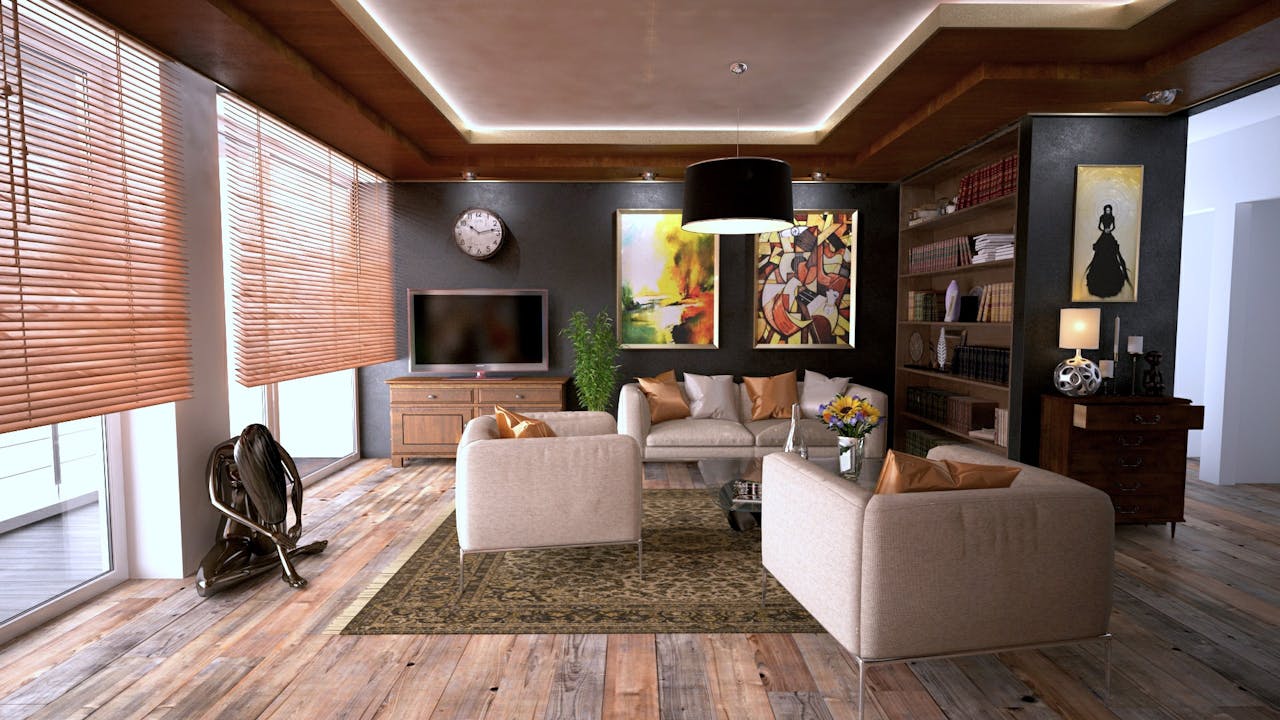Did you know that Victorian style interiors were once symbols of luxury and grandeur? They were known for intricate details and rich décor. During Queen Victoria’s reign from 1837 to 1901, interior Victorian homes were famous for their elaborate craftsmanship and opulent materials.
These homes were more than just places to live. They were statements of wealth and status. They featured distinct architectural elements like ornate moldings, archways, and ceiling medallions. For those interested in exploring more about Victorian home decor or incorporating elegant Victorian elements into their living spaces, there’s a wealth of inspiration to be found.
Key Takeaways
- Victorian homes are characterized by intricate craftsmanship and opulent materials.
- Distinct architectural features include ornate moldings and ceiling medallions.
- Rich color palettes and luxurious fabrics are hallmarks of Victorian style interiors.
- Victorian furniture is known for its ornate detailing and high-quality craftsmanship.
- Incorporating modern elements can refresh Victorian interiors.
Understanding Victorian Architecture
Exploring Victorian architecture reveals a rich history and design elements that captivate us. These homes showcase the architectural innovation of the 19th century. They are known for their intricate details and grand scale.
Key Characteristics of Victorian Homes
Victorian homes stand out with their intricate, ornamental details. The exterior boasts steep roofs, bay windows, turrets, and decorative trim. These features set the stage for the ornate interior design.
- Steep roofs with multiple gables
- Bay windows and turrets adding complexity
- Decorative trim and molding
Inside, the ornate moldings, archways, and ceiling medallions mirror the exterior. They create a cohesive and elaborate interior design.
The Evolution of Victorian Styles
Victorian architecture evolved over the 19th century, influenced by various styles and technological advancements. Initially, it was marked by Gothic Revival and Italianate styles. Later, it incorporated elements from the Arts and Crafts movement.
This evolution shows in the transition from heavily ornamented facades to more restrained, yet still intricate, designs towards the end of the century.
Iconic Elements in Interior Design
The interior of Victorian homes features several iconic elements, including:
- Ornate moldings and archways that frame doors and windows
- Ceiling medallions and rose centers adding a touch of elegance
- Rich, dark wood tones and heavy furnishings
These elements, combined with the elaborate exterior, define the classic Victorian aesthetic. It continues to inspire interior design today.
Color Palettes in Victorian Interiors
In Victorian interiors, colors are more than just design. They show grandeur and style. The Victorian era loved bold, dramatic colors. These colors made homes rich and luxurious.
Traditional Victorian colors include burgundy, emerald green, navy blue, and mustard yellow. These hues were used on walls, furniture, and accessories. This created a unified, opulent look.
Traditional Color Schemes
Victorian color schemes were bold and dramatic. Gold, ivory, and soft pastels were used to add contrast. This contrast made interiors interesting and deep.
| Color | Usage | Effect |
|---|---|---|
| Burgundy | Walls, Furniture | Creates a warm, luxurious atmosphere |
| Emerald Green | Accent Walls, Accessories | Adds a touch of elegance and sophistication |
| Navy Blue | Furniture, Decor | Provides a sense of calm and serenity |
Modern Interpretations of Victorian Colors
Today, we still love Victorian colors but with a twist. Modern Victorian interiors mix bold colors with lighter tones. This creates a balanced look.
For example, navy blue walls with crisp white trim and furniture is striking. It honors Victorian tradition but feels modern.
By using Victorian color palettes, we can make interiors elegant and historical. Yet, they can also feel contemporary and welcoming.
Flooring Options for Victorian Homes
The flooring in a Victorian home is more than just practical. It’s a statement of elegance from the era. When you’re restoring or renovating a Victorian house, picking the right flooring is key. It keeps the historic charm and looks right.
Classic Wood Flooring
Wood flooring was a must in Victorian homes. It was often made from hardwoods like oak, maple, or walnut. These floors were wide and long, showing off the era’s craftsmanship.
Key Features of Classic Wood Flooring:
- Durable and long-lasting
- Can be refinished multiple times
- Adds warmth and character to rooms
The Charm of Carpeting
Carpeting was also big in Victorian homes, in bedrooms and parlors. Luxurious fabrics like velvet and wool were used. They added to the home’s opulence.
Benefits of Carpeting:
- Provides a soft, comfortable surface
- Offers insulation against cold
- Can be used to create a cozy, intimate atmosphere
Tile and Stone Choices
In areas like kitchens and entryways, tile and stone flooring was used. Materials like marble, slate, and ceramic tiles were chosen for their durability and beauty.
Advantages of Tile and Stone:
- Highly durable and resistant to wear
- Easy to clean and maintain
- Available in a variety of patterns and designs
Here’s a comparison of the different flooring options:
| Flooring Type | Durability | Aesthetic Appeal | Maintenance |
|---|---|---|---|
| Classic Wood Flooring | High | Classic, Warm | Moderate |
| Carpeting | Moderate | Luxurious, Cozy | High |
| Tile and Stone | High | Elegant, Versatile | Low |
In conclusion, the flooring in a Victorian home greatly affects its look and feel. Knowing the pros and cons of different flooring options helps homeowners. They can choose what respects the home’s history while meeting today’s needs.
Furniture Styles That Define Victorian Interiors
Victorian furniture is known for its grandeur and elegance. The Victorian era loved opulence and grandeur. This has left a lasting mark on interior design, mainly in furniture styles.
Antique vs. Modern Furniture
Choosing between antique and modern furniture is key for a Victorian-style home. Antique furniture brings authenticity and a connection to the past. It often has intricate carvings and detailed craftsmanship.
Modern furniture inspired by Victorian styles offers a fresh take. It combines contemporary materials and comforts with Victorian elegance.
“The Victorian era’s furniture is characterized by its heavy, ornate style, reflecting the period’s love for grandeur and luxury.” – Interior Design Expert
Upholstery and Textiles
Upholstery and textiles are vital in Victorian furniture. Rich fabrics like velvet, silk, and patterned tapestries are key. The upholstery choice greatly affects a piece’s look and feel, from subtle tones to bold colors.
| Fabric Type | Characteristics | Use in Victorian Decor |
|---|---|---|
| Velvet | Luxurious, soft, and plush | Upholstery for armchairs and sofas |
| Silk | Smooth, lustrous, and elegant | Drapes, curtains, and upholstery |
| Tapestry | Intricately patterned, rich in detail | Upholstery, wall hangings |
Popular Furniture Pieces
Iconic Victorian furniture includes dark wood armchairs, settees, and coffee tables. They are adorned with intricate carvings and gilded accents. These pieces show the era’s love for luxury, detail, and craftsmanship.
- Dark wood armchairs with carved legs
- Ornate settees with velvet upholstery
- Coffee tables with intricate metalwork
By adding these furniture styles to your home, you can bring Victorian elegance into your space. This creates a sophisticated and inviting atmosphere.
Lighting Features in Victorian Homes
Lighting in Victorian homes is more than just a necessity. It’s key to the unique feel of these interiors. The right lighting can make a Victorian home look even more beautiful and refined.
Chandelier Elegance
Chandeliers are a big part of Victorian home lighting. Crystal chandeliers, in particular, bring a sense of luxury. Today, we see modern chandeliers that mix old designs with new tech, making them both stylish and practical.
A crystal chandelier can be a stunning centerpiece in a Victorian dining room. It adds a touch of luxury. Modern takes on traditional chandelier designs also blend Victorian elegance with today’s touches.
Importance of Natural Light
Natural light is just as important as artificial lighting in Victorian homes. Big windows, often with detailed designs, let in lots of natural light. This is a key feature of Victorian architecture.
Natural light does more than just light up a room. It also brings out the detailed designs and rich colors of Victorian interiors. Using mirrors or reflective surfaces can make the natural light even brighter, making the space feel more welcoming.
Vintage Lighting Fixtures
Vintage lighting adds to the charm of Victorian homes. Items like gas lamps, sconces, and lanterns bring a historical feel to the space.
Using vintage lighting fixtures is a great way to keep the Victorian look alive. It not only honors the original design but also adds a unique character to the home.
| Lighting Feature | Description | Impact on Victorian Interior |
|---|---|---|
| Chandeliers | Elegant, often crystal, and combining traditional design with modern technology. | Adds luxury and sophistication. |
| Natural Light | Utilizes large, intricately detailed windows to flood interiors with light. | Highlights rich colors and intricate details. |
| Vintage Fixtures | Includes gas lamps, sconces, and lanterns that add historical charm. | Preserves authenticity and adds character. |
Wall Treatments for Authenticity
Victorian homes are famous for their detailed wall treatments. These treatments add depth and character to the rooms. The walls were more than just a background; they were a canvas for showing off the era’s luxury and elegance.
Wallpaper was a key feature of Victorian wall treatments. It added texture, pattern, and color to rooms. Designs ranged from floral motifs and damask patterns to stripes and geometric shapes.
Wallpaper Trends of the Era
The Victorian era saw a rise in high-quality wallpapers. This made them more affordable for the middle class. Wallpaper designs were influenced by the Arts and Crafts movement and industrial advancements.
Popular designs included:
- Floral patterns with realistic flowers
- Damask designs for luxury
- Striped patterns for height or width
Interior design historians say wallpaper showed a homeowner’s status and taste.
“The variety of patterns and designs allowed homeowners to personalize their spaces in ways previously unimaginable.”
Molding and Millwork Designs
Molding and millwork were also key in Victorian wall treatments. They added sophistication and elegance to interiors.
Molding and millwork designs featured intricate patterns and shapes. These included:
| Design Element | Description | Common Locations |
|---|---|---|
| Crown Molding | Decorative molding where the wall meets the ceiling | Living rooms, dining rooms |
| Chair Rails | Molding to protect walls from chair backs | Dining rooms, hallways |
| Wainscoting | Paneling on the lower wall portion | Dining rooms, libraries |
Combining wallpaper, molding, and millwork created a rich look. This look is characteristic of Victorian interiors. Homeowners can achieve an authentic Victorian look by using these elements.
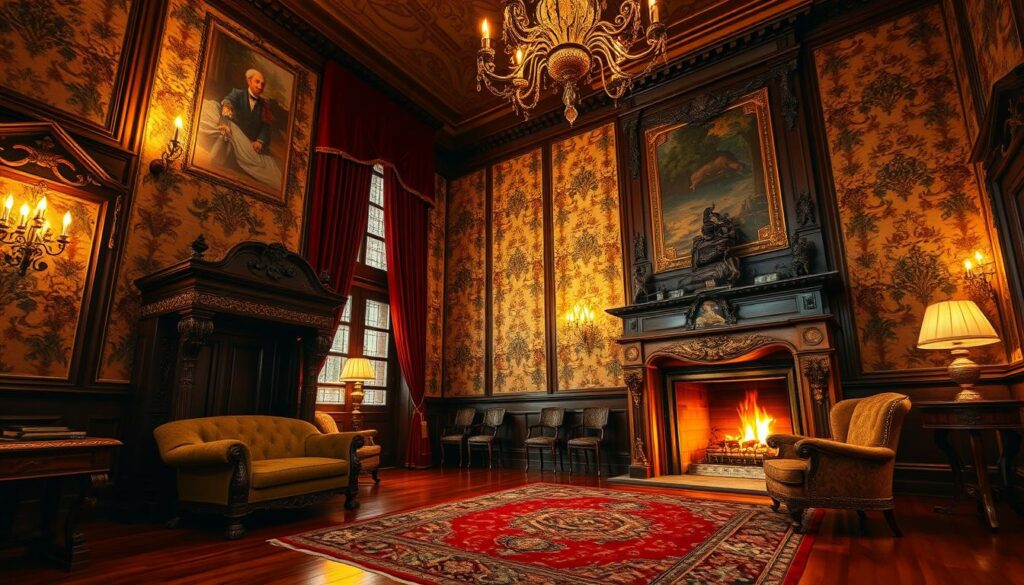
Kitchens in Victorian Homes
In the Victorian era, kitchens became a key part of home design. They mixed usefulness with luxury. As homes grew bigger and more detailed, kitchens turned from simple cooking spots to the heart of the home. They showed the family’s status and values.
Design Elements of a Victorian Kitchen
Victorian kitchens were known for their rich materials and detailed designs. Wooden cabinetry and ornate fixtures were key features. Cast-iron ranges and fancy sinks added both function and beauty.
The layout of Victorian kitchens had a central worktable. Storage and cooking areas were set around it. This design helped staff work efficiently, preparing meals.
Modern Amenities with Vintage Flair
Today, people can mix Victorian kitchen charm with modern features. Adding sleek appliances and high-quality countertops like quartz or granite makes the space both beautiful and practical.
An island with a breakfast bar boosts the kitchen’s use. It also acts as a social spot, just like in Victorian times. Custom cabinets can match Victorian styles but still offer lots of storage.
| Design Element | Victorian Era | Modern Interpretation |
|---|---|---|
| Cabinetry | Rich woodwork, intricate carvings | Custom designs with modern hardware |
| Countertops | Marble, soapstone | Quartz, granite |
| Appliances | Cast-iron ranges | Sleek, high-efficiency appliances |
The Role of Fabrics in Victorian Design
The opulence of Victorian interiors comes from luxurious fabrics. These materials added texture and depth to rooms. They also defined the look of elegant Victorian homes. We’ll see how fabrics made historic Victorian interiors grand.
Curtains and Drapes
Curtains and drapes were key in Victorian decor. They were made from heavy fabrics like velvet, silk, and brocade. These were often decorated with intricate patterns and tassels.
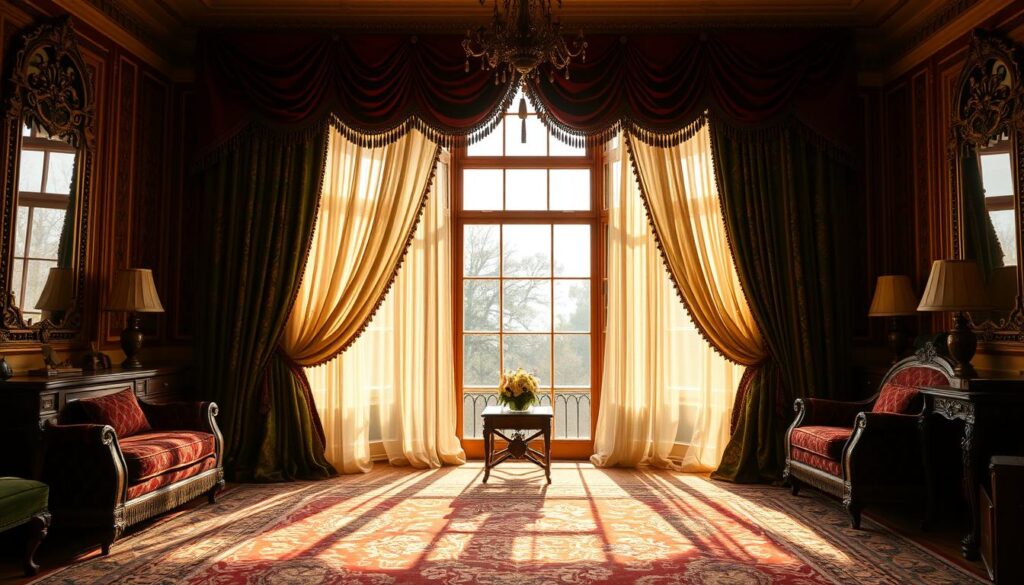
Upholstered Surfaces
Fabrics were also key in upholstered furniture. Chairs, sofas, and ottomans were covered in deep, jewel-toned fabrics. This made spaces cozy and inviting.
The rich textures in upholstery added comfort and visual richness to rooms.
| Furniture Piece | Common Fabric | Characteristics |
|---|---|---|
| Sofas | Velvet, Brocade | Luxurious, Heavy, Patterned |
| Armchairs | Silk, Velvet | Elegant, Soft, Often Embroidered |
| Ottomans | Leather, Velvet | Versatile, Comfortable, Luxurious |
Throw Pillows and Accent Pieces
Throw pillows and accents added color and texture to Victorian interiors. They were often made from fabrics that matched or complemented the furniture. This created a cohesive look.
These accents let homeowners personalize their spaces while keeping the era’s opulence.
In conclusion, fabrics were crucial in Victorian design. They added luxury and elegance to the era’s interiors. Understanding their role helps us appreciate the beauty of historic Victorian interiors.
Outdoor Spaces and Victorian Aesthetics
The charm of Victorian outdoor spaces comes from mixing elegance with practicality. The Victorian era’s love for detail isn’t just inside homes. It also extends to gardens and outdoor areas, creating a smooth transition from indoors to outdoors.
Garden Design Inspirations
Garden design in the Victorian era was all about nature. It mixed formal and informal styles, with lots of greenery and colorful flowers. To get this look, we can use different plants, including native ones for a green and easy-care garden.
Adding vintage Victorian decor like old garden furniture or fancy planters makes the garden feel real. When planning a Victorian garden, think about using shapes, paths, and fancy features like fountains or statues. These add beauty and calmness. We can also take inspiration from the era’s love for botanical gardens, using a variety of plants that were popular back then.
Patios and Porches
Patios and porches are key parts of Victorian outdoor spaces. They connect the house to the garden. These spots are great for adding Victorian style interiors elements outside, like detailed woodwork, fancy furniture, and rich fabrics. This makes our outdoor areas welcoming and elegant, just like the Victorian era.
To make our outdoor spaces look Victorian, we can use furniture that matches the detailed look of indoor pieces. Adding things like lanterns, planters, and wall hangings can make the space even more special. It’s also important to use materials that can stand up to the weather but still look good.
By designing our outdoor spaces with Victorian-inspired elements, we can make a welcoming area that feels like part of our home. Whether it’s through garden design or using patios and porches, adding vintage Victorian decor and Victorian style interiors can make our outdoor spaces a true extension of our homes.
How to Incorporate Victorian Style Today
Understanding Victorian décor helps us create a space that looks back while living in the now. By adding Victorian touches to our homes, we celebrate the beauty of Victorian design.
Blending Modern and Traditional Elements
Mixing modern and Victorian styles is key to a balanced look. For example, we can pair old furniture with new lights or mix classic colors with modern floors. This mix creates a unique and eye-catching Victorian look.
DIY Projects for a Victorian-Inspired Home
DIY projects are a great way to add Victorian flair to our homes. Simple tasks like updating molding or adding vintage lights can change a room. We can also use old items or make our own Victorian decor.
Adding Victorian style to our homes is about finding a balance. By mixing old and new, we make a space that’s both stunning and practical. It shows off the elegance of Victorian design.

